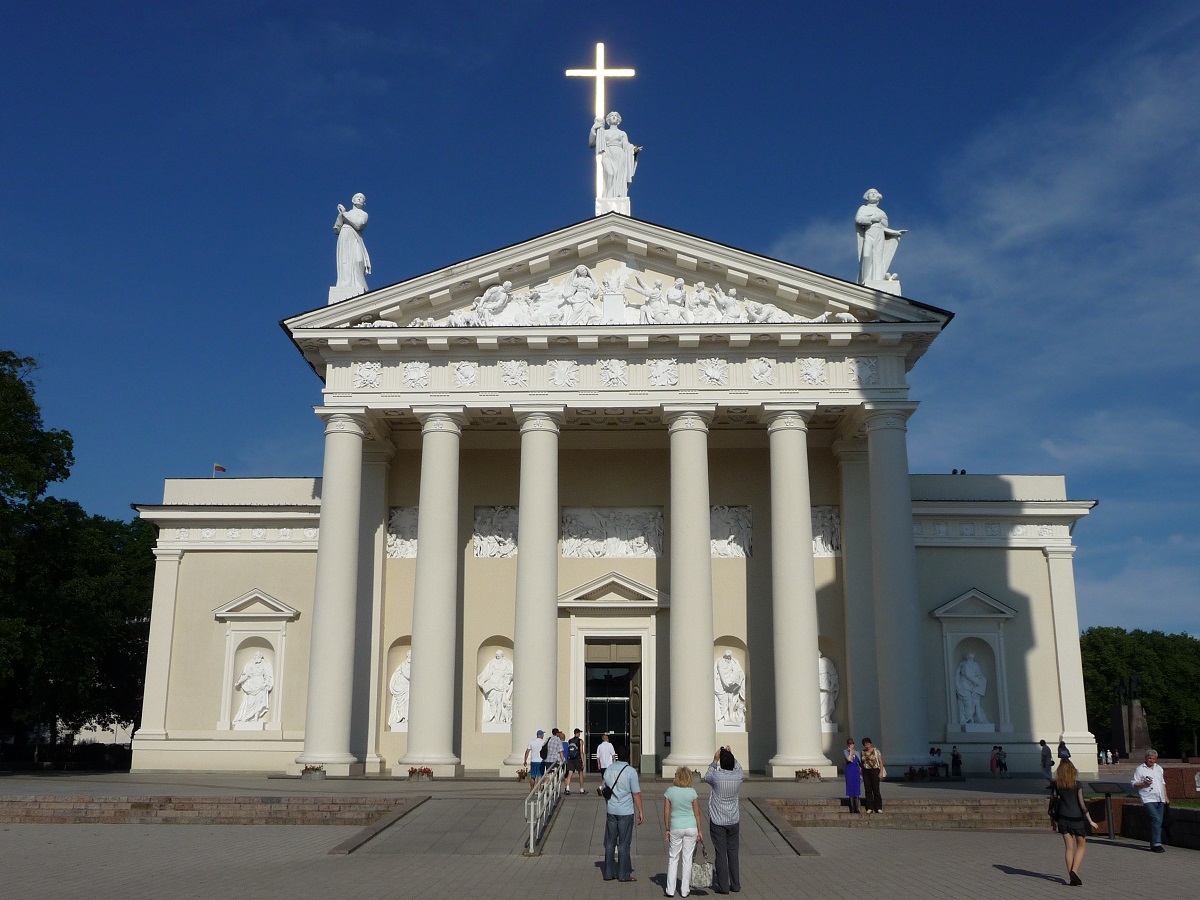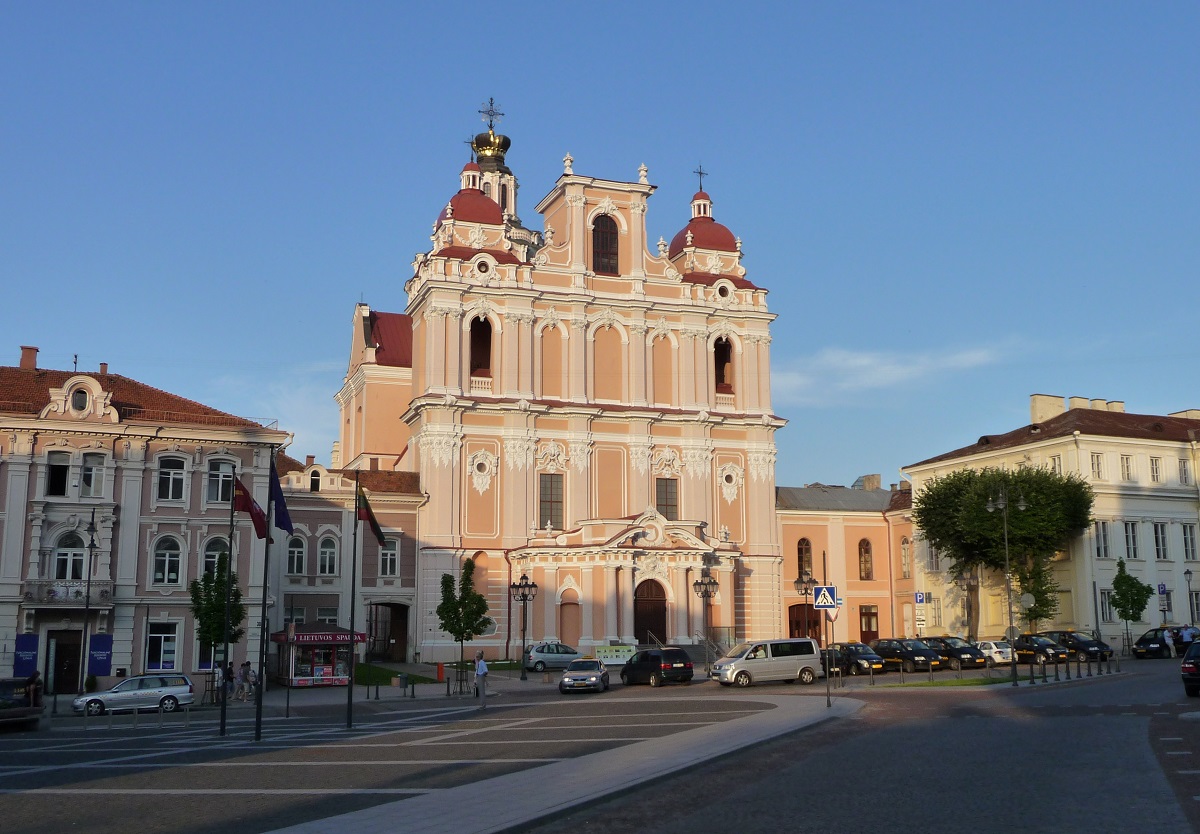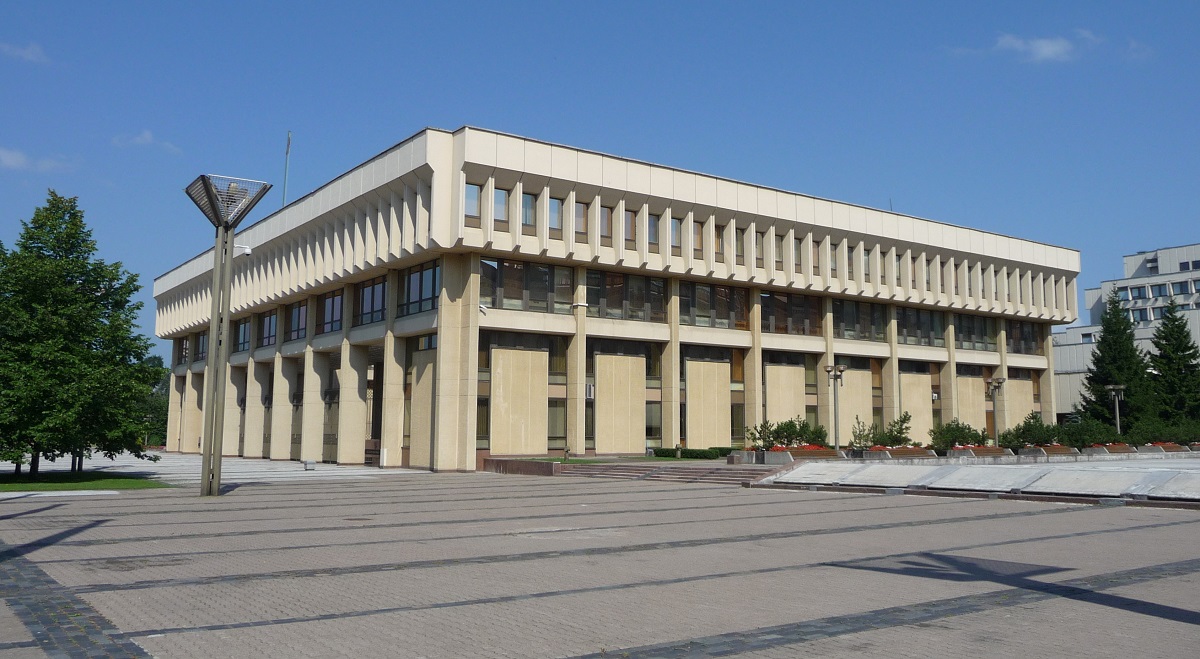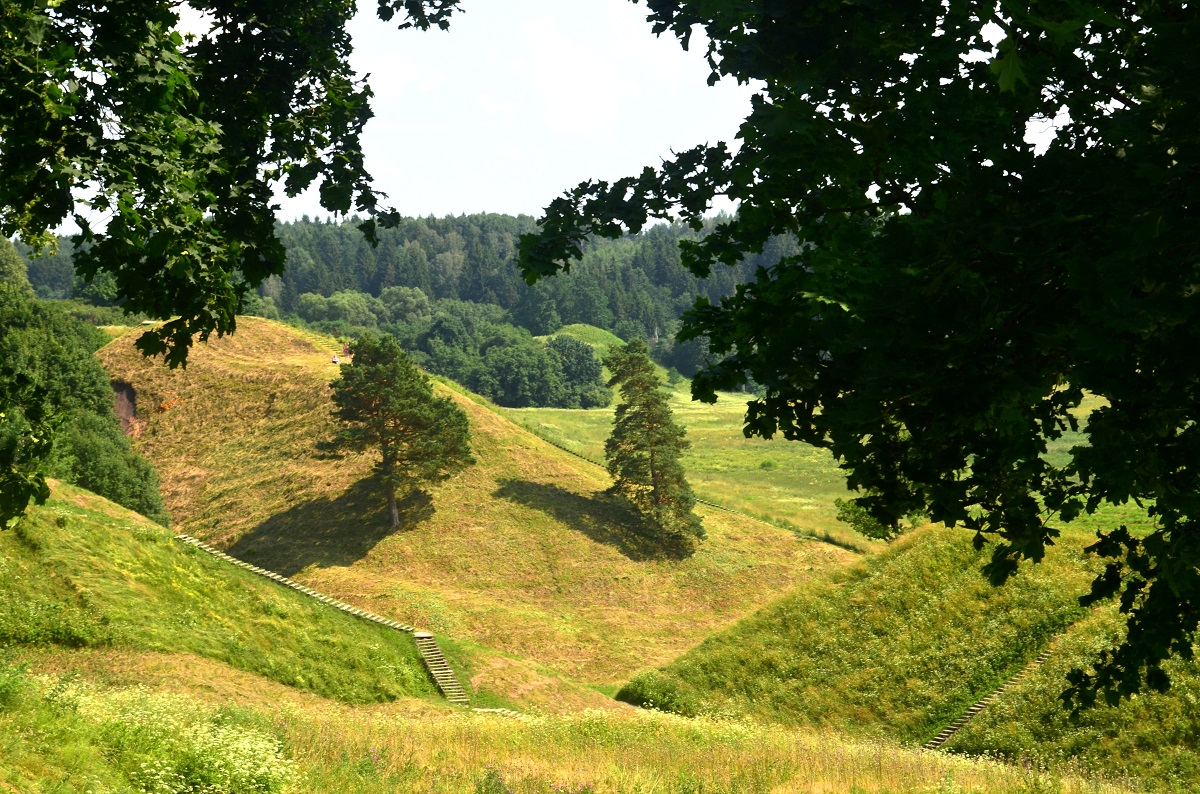Vilnius is the capital of Lithuania and at the same time a city with an atmosphere that is a nice mix of the Baltic area and Central Europe. Baroque building style and, not least, countless churches characterize the narrow and pleasant streets of the city center, but it is not far to modern neighborhoods which add a cosmopolitan touch.
Small and large squares are all around the old center. And there are many interesting museums, monuments and other sights to enjoy. Shopping, culture and gastronomy are something else that are parts of the Vilnius experience.
A special sight is the elegant cathedral of the city and the ridges that rise east of the cathedral and the river Neris. Here are landmarks as Gediminas Tower, the former royal palace, the national museum and other fine and interesting things.
In the vicinity of Vilnius there are many beautiful places. The geographical center of Europe is marked a short drive north of the city, and to the west is the mighty Trakai Island Castle. A bit further you come to the Soviet city of Elektrenai and the country’s second largest city, Kaunas. The distances are not long, and all the sights are great place for a day trip.

At the Vilnius Cathedral Square, the city’s cathedral stands majestically with its freestanding tower. The cathedral is the Roman Catholic main church in Lithuania and was built in its current design in years 1779-1783.
Historically, Vilnius and Lithuania have been a significant power in the region with grand dukes and kings on the throne. The royal palace of the city is a beautiful reconstruction of the historic castle.

In 1409, Grand Duke Vytautas built the first stone castle on the top of Vilnius, and this tower originates from his structure. There is a magnificent view of the city from the tower.
The television tower in Vilnius is one of the tallest buildings in Eastern Europe at 326.5 meters/1,071 ft in height. There is a restaurant and observation deck at mid level, from which there is a magnificent panoramic view of Vilnius.

St Anne’s Church is one of Vilnius’ landmarks. It is a late Gothic masterpiece without many similar buildings of the world in its blend of multiple gothic-style elements.

This is Vilnius’ main entrance from the south through the now historic city wall. The gate was an integral part of the city’s defense, and it is now the only one preserved of the original nine city gates.
The All Saints Church was built in the years 1620-1630 in a beautiful Late Baroque style. However, the church tower, which stands next to the church, was erected later, in 1743. The church offers a beautiful nave.

St. Kazimir Church is a beautiful Baroque church that was the first one in this style in Vilnius. The church was built by the Jesuits in the years 1604-1618. The church interior is among Vilnius’ most impressive.
This is Vilnius City Hall and thus the center of the city’s political rule. The city hall has been here since the 15th century. The present construction was built in the years 1785-1799 in neoclassical style.

The Presidential Palace is the official residence of the President of Lithuania, and it is a status that the house has enjoyed since 1997. However, the building’s history dates back to the 1300s as a residence for the city’s bishop.
Užupis is the name of a neighborhood located just east of the old town of Vilnius. The neighborhood has attracted artists and bohemians with all that it brings of culture, charm and cosiness.

At a hill above Vilnius, according to tradition, three crosses were first erected in honor of 14 slain monks in the 1600s. The crosses are still there in a recent edition and constitute one of Vilnius’ famous sights.
At this museum you will find a comprehensive archaeological, ethnographic and historical collection depicting Lithuania through exhibitions in various themes.

The Lithuanian Parliament is called Seimas, and it has existed since 1992, when it officially replaced the Supreme Soviet as the country’s most important parliamentary assembly.
This house was the headquarters of the Soviet security service, KGB, in Vilnius during the Soviet Union era in the latter half of the 20th century. Today there is a museum about the period in the building.

This beautiful church belongs to the Orthodox congregation and was consecrated in 1903 after its construction on the initiative of the Orthodox Brotherhood of the Holy Spirit.

Trakai’s beautiful island castle is the central building in the city of the same name. It was built from the 1300s in the middle of the large beautiful lake area, which it is completely surrounded by.
Lithuania is the geographical center of Europe and the very center of the continent lies close to the northeast of Vilnius and it is marked with a monument.

The village of Kernavė is considered to be Lithuania’s oldest capital. The town was first mentioned in 1279 and today the medieval castle is the main attraction in Kernavė.
The city of Elektrėnai is a very different experience than the old cultural city of Vilnius. It was built as a modern model town around a power plant in the Soviet Union in the 1960s.

The village of Rumšiškės is beautifully situated on Lake Kauno Marios. Rumšiškės is home to Lithuania’s fine ethnographic open-air museum, which displays parts of the country’s culture and building style from the 18th century to the present.
The city of Kaunas is the second largest in Lithuania. It is beautifully located where the rivers Neris and Nemunas confluence, and there are countless sights to experience in the city. Among other things, interesting museums and beautiful churches.
Ozo g. 25
akropolis.lt
Konstitucijos 7a
europa.lt
Gedimino prospectas 16
flagman.lt
Gedimino prospectas 9
gedimino9.lt
Savanorių 16
rimi.lt
Jasinskio 16 & Zirmūnų 2
iki.lt
Ozo g. 18
Saltoniškių 9
panorama.lt
Upės 9
vcup.lt
Gedimino prospektas, Didžioji gatvė, Pilies gatvė
Vandens Parkas
Ozo g. 14
vandensparkas.lt
Lietuvos Gelezinkeliu muziejus
Geležinkelio g. 16
litrail.lt
Energetikos ir technikos muziejus
Rinktinės g. 2
etm.lt
Žaislų muziejus
Šiltadaržio g. 2
zaislumuziejus.lt
Pinigų muziejus
Totorių g. 2/8
pinigumuziejus.lt
Vilniaus universiteto Zoologijos muziejus
Gyvybės mokslų centers, C106, Saulėtekio al. 7
zoo.muziejus.vu.lt
Akropolis
Ozo g. 25
akropolis.lt
X-PLANET šeimos pramogų parkas
Ozo g. 18
xplanet.lt
The capital Vilnius is one of Lithuania’s oldest cities, and the area is believed to have been inhabited since at least the early Middle Ages; Excavations, however, have shown traces of settlements in the area, dating back to around the year 100.
Vilnius is first mentioned by Duke Gediminas in 1323, which is considered the city’s foundation, and from that time the settlement on the banks of the Neris River developed.
The capital of the area was before Gediminas Kernave northwest of Vilnius, but when the duke, during a hunt, found Trakai’s beautiful lake area, he built a castle and moved the capital to it. According to legend, he had to spend another night at Vilnius’ current location, where he had a dream of once again founding the new capital at this particular place, what he did with the construction of two castles.
After its founding in 1323, just two years later, Gediminas wrote to Germans and Jews in the Hanseatic cities along the Baltic Sea that everyone was welcome in his town to settle down to trade and craft. However, it was not until later in the 1300s that foreign merchants and craftsmen moved in earnest.
The year 1387 became an important year for Vilnius and Lithuania. The country was christened as the last pagan land in Europe by Władysław II Jagiełło, the Lithuanian Grand Duke and Polish King. In the same year the construction of Vilnius’ cathedral began, and the city was also granted commercial property rights in precisely 1387; however, these only applied in the part of the city where the Catholic bishop was leader.
The ancient Vilnius developed over the centuries, and the more than 1,200 preserved historic buildings are one of the largest numbers in Eastern and Central Europe. Urban planning adapted to nature with the river and the hilly area.
Many cultures flowed to Vilnius, known for its tolerance of religion. Over time, among other things, Baroque-style Orthodox and Catholic churches have been erected and Renaissance-style synagogues. Already from the end of the 1300s and through the 1400s there was a lot of construction activity, and after inspiration from other European cities, Vilnius’ craftsmen joined in low during this period.
The diversity of cultures was reflected in the architecture, which you can still see in the richly ornamented buildings in the city. Vilnius’ population groups also established themselves in separate neighborhoods; the Orthodox Christians lived to the east, while Germans and Jews lived to the west. Increasingly, Poles also came to the city.
At the beginning of the 16th century, the Crimean Tatars posed a threat to Vilnius, and between 1503 and 1522 the city was expanded with fortress walls, which had three defense towers and nine city gates.
Vilnius reached a peak in 1544, when Sigismund II August, as Lithuanian Grand Duke and Polish King, moved the court to Vilnius. Sigismund stayed extensively in Vilnius, which strengthened the city’s growth and political status.
With the court in Vilnius, more Poles continued to come to Vilnius, and over time a significant Polish influence on life and the country happened. This development had just started with the arrival of Polish clergy in the late 1300s, but through the 16th century the development took off.
In terms of construction, it was the period after the Gothic period, and through the 16th century a number of Renaissance buildings were erected before Vilnius’ special Baroque style broke through in many church and mansion buildings.
With the Lublin Union in 1569, Poland and Lithuania transitioned from having a personal union to forming a real union. In the first half of the 16th century, Lithuania had a territory that stretched from the Baltic to the Ottoman Empire a little south of Kiev, but by the 1560s a large part had passed to the Polish crown. With the union, Vilnius and Krakow became the main cities until 1793, when Warsaw achieved this status until the union’s final in 1795.
The first time in the real union was a period of great flourishing for Vilnius. In 1579, the Lithuanian Grand Duke and the Polish King founded a university in the city, which became the leading educational and research site in the region. The city’s social and cultural life shone and the city received many new migrants.
In 1610, Vilnius was ravaged by a major fire and some reconstruction was to be completed. In 1655, Russian forces conquered Vilnius during the Russian-Polish War, which took place in the years 1654-1667. During the war and fighting in Vilnius, part of the city was destroyed, and the result of the whole war was in the long run that Russia conquered lands to the west and thereby to the Polish-Lithuanian territory. On that occasion, Vilnius’ growth was halted for a time.
Throughout the latter half of the 18th century, classicism dominated the architecture of Vilnius. That and much else was changed in the 1790s, when Warsaw first became the capital in 1793, and in 1795 Poland-Lithuania was dissolved.
Through the so-called third division of Poland-Lithuania, Vilnius and Lithuania became part of the tsar’s Russia, and it became infected in many areas; obviously political, but also cultural and architectural. During the Russian era, part of the city’s many churches and monasteries were closed down and Byzantine-style churches were erected instead.
Vilnius again became the capital; this time in the Russian government in Lithuania. A few years later, the city walls were demolished to allow the city to grow again. The Czar allowed the Polish university to reopen in 1803, and there was again some development in the city.
Vilnius developed industrially through the 19th century, and this happened not least after the opening of the rail link from Saint Petersburg to Warsaw in 1860. The route passed through Vilnius, which led to increased traffic and trade.
In the 19th century, the Lithuanian desire for independence grew, and several Lithuanian institutions eventually emerged. These included the Vilniaus žinios newspaper, which was published in 1904 following the lifting of a ban on Lithuanian press in Latin letters.
During World War I, Vilnius was occupied by German troops for over three years before the country declared its independence on February 16, 1918. However, the fighting was not over at that time. The German troops withdrew on January 1, 1919, leaving the city to a Polish garrison.
Four days later, the Bolsheviks invaded Vilnius, and they declared the city the capital of the Lithuanian-Belarusian Socialist Soviet Republic. Later, both Poland and the Soviet Union regained Vilnius. On July 12, 1920, a peace treaty between the Soviet Union and Lithuania was signed and Lithuania gained recognition as an independent country. However, while the rest of Lithuania became independent, Vilnius became part of Poland. Kaunas became the capital of Lithuania, while Vilnius became the seat of a regional Polish government.
Between 1920 and 1939, Poles made up about 65% of Vilnius’s population, while the Jewish share was 28%. There were only about 1% Lithuanians left in the city.
During the Polish era, Vilnius underwent some development. Factories were built and a new trade fair saw the light of day in 1928. A modern department store was opened for consumers and the university in the city was re-created.
In 1939, World War II broke out, and with the Molotov-Ribbentrop Pact, the Vilnius region became a Soviet sphere of interest. The Red Army quickly overcame the Polish defense of Vilnius in September 1939, and the city was subjugated to the Belarusian Socialist Soviet Republic.
The Soviet Union had occupied Vilnius, but in October a Lithuanian delegation flew to Moscow for a dialogue and the area. An agreement was reached between the Soviet leadership and Lithuania, which returned Vilnius to independent Lithuania.
With almost 200,000 inhabitants in the 1930s, Vilnius had been one of Poland’s largest cities, but after 1939 the population of the population changed. Tens of thousands of Lithuanians were moved to the city, where it was actively sought to dispose of all Polish and, in part, also Jewish in favor of Lithuanian. Among other things, Poles in the city were formally made foreigners.
In 1940, Vilnius, along with the rest of Lithuania, became the Lithuanian Soviet Republic with the capital of precisely Vilnius. The following year, the city and the country were occupied by German troops, and Germany created Jewish ghettos in the city. The German occupation lasted until July 1944, when advancing Soviet troops liberated the country and Vilnius, which in turn became the capital of the Lithuanian Soviet Republic.
After the end of World War II, a massive urbanization occurred in the 1960s-1980s, resulting in large-scale newly built suburbs. Culturally, Vilnius flourished, the university was renovated and major city-building projects included the city’s opera and TV tower.
In Vilnius there were demonstrations in the streets in the late 1980s. The protesters wanted Lithuanian independence from the Soviet Union, and on March 11, 1990, the country’s parliament declared Lithuania independent.
On January 13, fighting between Lithuanians and the Soviet military moved into Vilnius. In August of that year, the Soviet Union recognized Lithuania’s independence and Vilnius remained the capital.
In 2004, Lithuania became a member of the European Union and its capital has undergone major changes since the 1990s. Today, Vilnius stands beautifully renovated and inviting for tourists who want to discover the beautiful old town that stretches through a long time of the history of the Lithuanian capital.
Overview of Vilnius
Vilnius is the capital of Lithuania and at the same time a city with an atmosphere that is a nice mix of the Baltic area and Central Europe. Baroque building style and, not least, countless churches characterize the narrow and pleasant streets of the city center, but it is not far to modern neighborhoods which add a cosmopolitan touch.
Small and large squares are all around the old center. And there are many interesting museums, monuments and other sights to enjoy. Shopping, culture and gastronomy are something else that are parts of the Vilnius experience.
About the upcoming Vilnius travel guide
About the travel guide
The Vilnius travel guide gives you an overview of the sights and activities of the Lithuanian city. Read about top sights and other sights, and get a tour guide with tour suggestions and detailed descriptions of all the city’s most important churches, monuments, mansions, museums, etc.
Vilnius is waiting for you, and at vamados.com you can also find cheap flights and great deals on hotels for your trip. You just select your travel dates and then you get flight and accommodation suggestions in and around the city.
Read more about Vilnius and Lithuania
Buy the travel guide
Click the “Add to Cart” button to purchase the travel guide. After that you will come to the payment, where you enter the purchase and payment information. Upon payment of the travel guide, you will immediately receive a receipt with a link to download your purchase. You can download the travel guide immediately or use the download link in the email later.
Use the travel guide
When you buy the travel guide to Vilnius you get the book online so you can have it on your phone, tablet or computer – and of course you can choose to print it. Use the maps and tour suggestions and you will have a good and content-rich journey.
Cathedral • Beautiful Baroque • Užupis • Gedimino • Trakai
Overview of Vilnius
Vilnius is the capital of Lithuania and at the same time a city with an atmosphere that is a nice mix of the Baltic area and Central Europe. Baroque building style and, not least, countless churches characterize the narrow and pleasant streets of the city center, but it is not far to modern neighborhoods which add a cosmopolitan touch.
Small and large squares are all around the old center. And there are many interesting museums, monuments and other sights to enjoy. Shopping, culture and gastronomy are something else that are parts of the Vilnius experience.
About the upcoming Vilnius travel guide
About the travel guide
The Vilnius travel guide gives you an overview of the sights and activities of the Lithuanian city. Read about top sights and other sights, and get a tour guide with tour suggestions and detailed descriptions of all the city’s most important churches, monuments, mansions, museums, etc.
Vilnius is waiting for you, and at vamados.com you can also find cheap flights and great deals on hotels for your trip. You just select your travel dates and then you get flight and accommodation suggestions in and around the city.
Read more about Vilnius and Lithuania
Buy the travel guide
Click the “Add to Cart” button to purchase the travel guide. After that you will come to the payment, where you enter the purchase and payment information. Upon payment of the travel guide, you will immediately receive a receipt with a link to download your purchase. You can download the travel guide immediately or use the download link in the email later.
Use the travel guide
When you buy the travel guide to Vilnius you get the book online so you can have it on your phone, tablet or computer – and of course you can choose to print it. Use the maps and tour suggestions and you will have a good and content-rich journey.

This is Vilnius’ main entrance from the south through the now historic city wall. The gate was an integral part of the city’s defense, and it is now the only one preserved of the original nine city gates.
The All Saints Church was built in the years 1620-1630 in a beautiful Late Baroque style. However, the church tower, which stands next to the church, was erected later, in 1743. The church offers a beautiful nave.

St. Kazimir Church is a beautiful Baroque church that was the first one in this style in Vilnius. The church was built by the Jesuits in the years 1604-1618. The church interior is among Vilnius’ most impressive.
This is Vilnius City Hall and thus the center of the city’s political rule. The city hall has been here since the 15th century. The present construction was built in the years 1785-1799 in neoclassical style.

The Presidential Palace is the official residence of the President of Lithuania, and it is a status that the house has enjoyed since 1997. However, the building’s history dates back to the 1300s as a residence for the city’s bishop.
Užupis is the name of a neighborhood located just east of the old town of Vilnius. The neighborhood has attracted artists and bohemians with all that it brings of culture, charm and cosiness.

At a hill above Vilnius, according to tradition, three crosses were first erected in honor of 14 slain monks in the 1600s. The crosses are still there in a recent edition and constitute one of Vilnius’ famous sights.
At this museum you will find a comprehensive archaeological, ethnographic and historical collection depicting Lithuania through exhibitions in various themes.

The Lithuanian Parliament is called Seimas, and it has existed since 1992, when it officially replaced the Supreme Soviet as the country’s most important parliamentary assembly.
This house was the headquarters of the Soviet security service, KGB, in Vilnius during the Soviet Union era in the latter half of the 20th century. Today there is a museum about the period in the building.

This beautiful church belongs to the Orthodox congregation and was consecrated in 1903 after its construction on the initiative of the Orthodox Brotherhood of the Holy Spirit.
Similar to Vilnius Travel Guide
There are no listings matching your search.
Reset